Traction Alopecia: When is it Too Late?

With the increased popularity of braids and man buns, more and more people suffer from traction alopecia.
This condition can be distressing, as it affects not only the appearance but also the health of the scalp.
Understanding when it’s too late to reverse traction alopecia is crucial for individuals seeking to restore their hair.
Thankfully we are here to help!
Today we will tell you everything you need to know, including causes, symptoms and ways to treat traction alopecia.
- When is it too late to reverse it?
- What is traction alopecia?
- Stages
- Causes
- Prevention
- How is it diagnosed?
- Photos of traction alopecia
- Treatment
When is it too late to reverse traction alopecia?
Traction alopecia is usually reversible up until the later stages. It’s crucial to address traction alopecia when you notice signs like thinning, breakage, or bald spots.
Early intervention can significantly increase the chances of regrowing healthy hair.
If left unaddressed for a longer period, the condition may cause permanent hair loss.
What is traction alopecia?
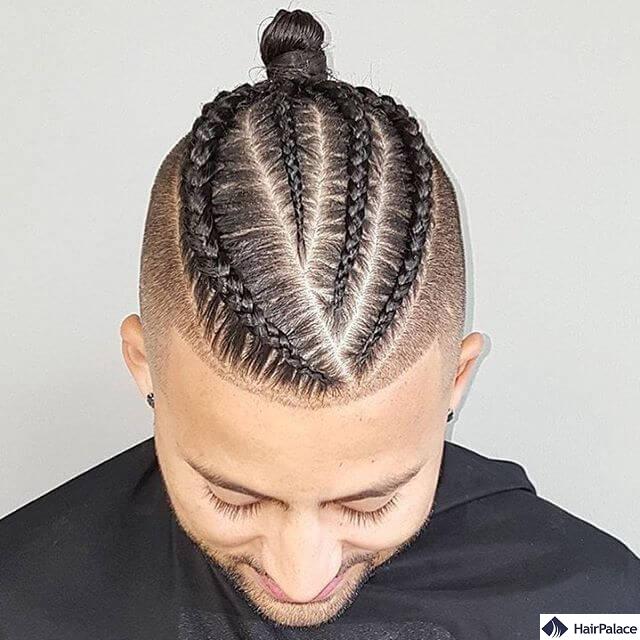
Traction alopecia is a type of hair loss that occurs due to prolonged tension or pulling on the hair.
This condition is common in individuals with hair styling practices that exert continuous stress on the hair follicles.
Constant pulling can lead to thin or broken hair that eventually falls out.
Untreated traction alopecia can easily lead to thinning or bald patches, particularly around the hairline.
The hair loss usually progresses gradually, making it less noticeable at first.
Over time, it can become more pronounced if the hairstyle causing the tension is not changed.
Traction alopecia stages
Early signs of traction alopecia
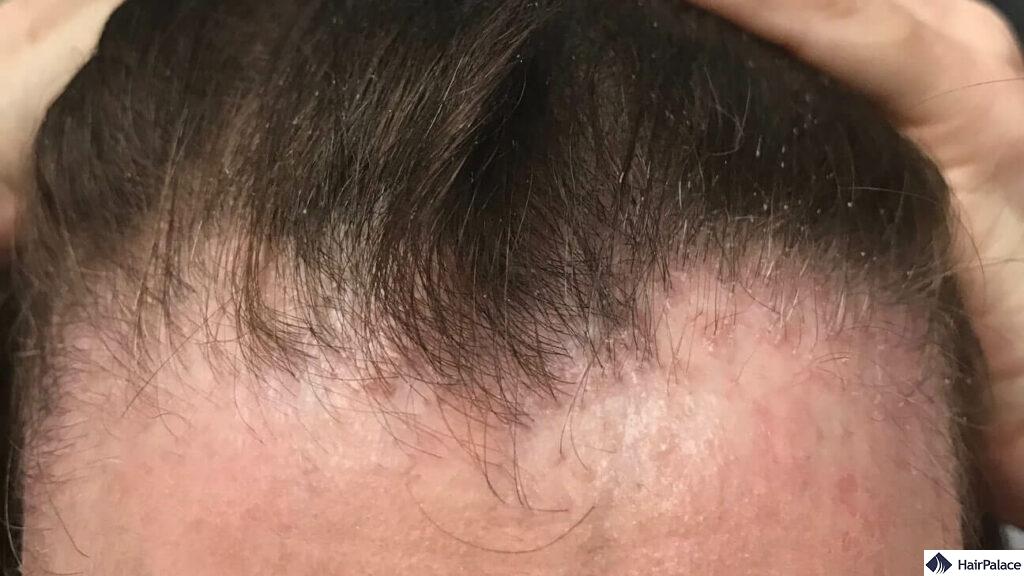
You may notice gradual thinning of hair, particularly around the hairline, and the temples.
Hair strands may become weaker and more prone to breakage, especially near the roots.
In the early stages, your scalp may show signs of redness, mild inflammation, or irritation where the tension is greatest.
There may be tenderness or discomfort in areas where the hair is being pulled.
At this stage, if less damaging hair practices are adopted, the hair loss can often be reversed.
Late-stage traction alopecia
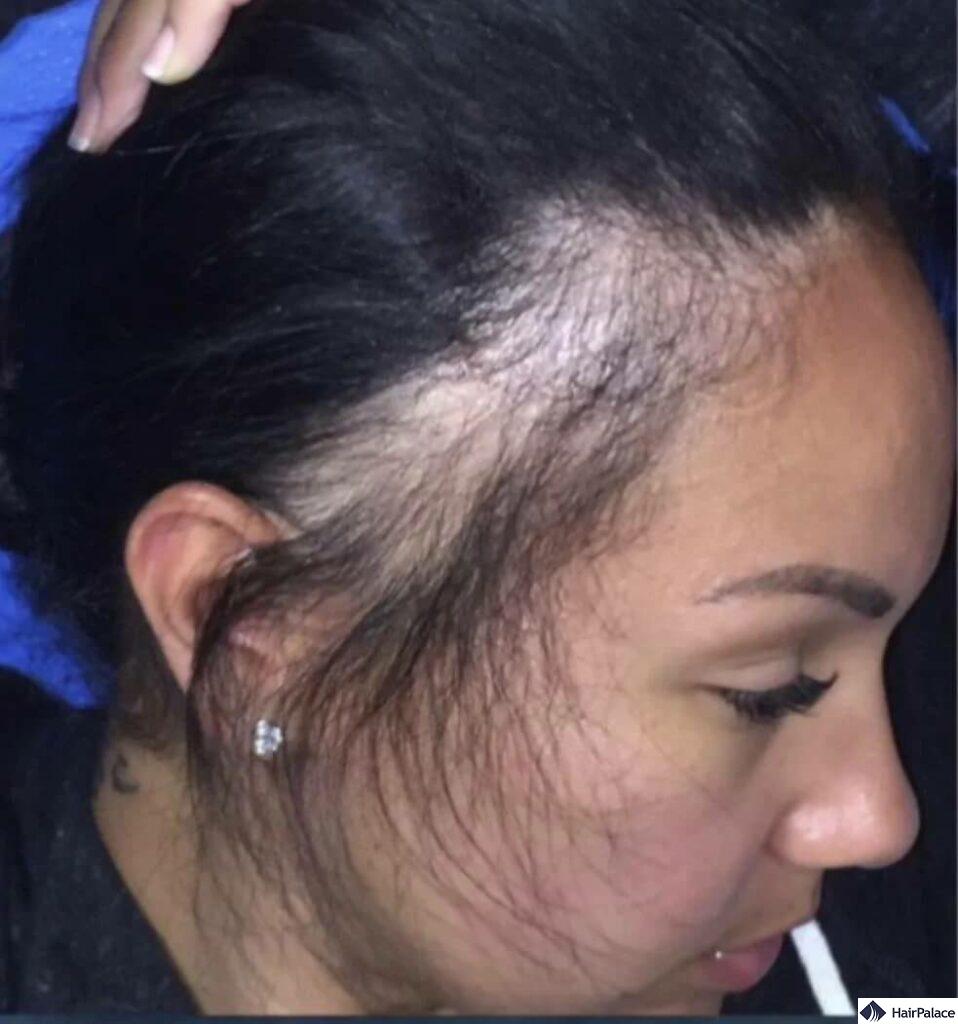
Advanced traction alopecia typically manifests itself in visible bald patches, particularly along the hairline or areas of sustained tension.
Hair follicles may become permanently damaged, leading to irreversible hair loss in affected areas.
The scalp may appear shiny or smooth in these areas, indicating scarring.
If the condition has progressed to scarring alopecia, the hair follicles are destroyed, and new hair cannot grow.
The affected scalp may show signs of fibrosis (scarring), which makes regrowth unlikely without surgical intervention.
The hair follicles may shrink or disappear entirely, making hair regrowth impossible in the affected areas without medical treatment like hair transplants.
What causes traction alopecia?
It is caused by repeated and prolonged tension or pulling on the hair, which can damage the hair follicles over time.
Tight Hairstyles
Wearing tight ponytails or frequently can put strain on the hair, especially around the hairline and temples.
Similarly, tight braids, such as cornrows, box braids, or other similar styles, can also cause significant tension on the scalp.
Hair Accessories
Using tight hairbands, rubber bands, or elastics can cause hair breakage and traction alopecia, particularly if used repeatedly in the same spot.
Hair clips, pins, or barrettes that are tightly secured to the hair can also contribute to the problem if used frequently.
Chemical Treatments
Chemical relaxers that straighten hair can weaken the hair shaft, making it more susceptible to damage from tension.
Regular use of chemical straighteners or perms can weaken hair, exacerbating the effects of tight hairstyles.
Frequent Styling
Excessive use of heat-styling tools like flat irons or curling irons can weaken hair, making it more prone to breakage when combined with tension.
The constant manipulation of hair into tight styles without giving the hair a break can increase the risk of developing it.
Overusing hair gels can also contribute to increased hair loss.
Scalp Conditions
Individuals with sensitive or inflamed scalps are more susceptible to traction alopecia, as they are more susceptible to broken hairs and thus hair loss.
Can you prevent traction alopecia?

Traction alopecia can often be prevented by adopting healthy hair care practices and avoiding hairstyles or habits that put excessive tension on the hair.
Here are some strategies to help prevent the condition:
- Avoid Tight Hairstyles: Avoid hairstyles that pull tightly on your hair, and regularly change your hairstyle to avoid putting repeated stress on the same areas of your scalp.
- Be gentle: Choose hair accessories made of soft materials instead of rubber hair ties.
- Limit Chemical Treatments: Minimize the use of chemical treatments that weaken the hair shaft.
- Stop wearing hair extensions: If you choose to wear hair extensions or weaves, opt for lighter options that place less strain on each hair follicle.
- Practice Good Hair Care: Keep your scalp and hair moisturized to maintain their strength and elasticity, reducing the likelihood of breakage.
- Give Your Hair Regular Breaks: Regularly take down tight hairstyles and allow your hair to rest.
- Pay Attention to Your Scalp: If you notice any signs of hair thinning, redness, or irritation, change your hairstyle immediately to reduce tension on your hair.
By following these preventative measures, you can significantly reduce the risk of developing traction alopecia and maintain healthier hair and scalp conditions.
How is traction alopecia diagnosed?
Traction alopecia is diagnosed primarily through a clinical examination by a dermatologist or trichologist.
The diagnosis process typically involves the following steps:
The doctor will ask about your hair care routine, including the types of hairstyles you frequently wear and any use of chemical treatments.
You’ll be asked about any signs of traction alopecia you’ve noticed, such as hair thinning, breakage, scalp tenderness, or redness.
The doctor will closely examine your scalp, particularly in areas where tension is most likely applied (e.g., hairline, temples).
They will look for signs of hair thinning, breakage, bald patches, redness, or inflammation.
Finally, they may use a dermatoscope to magnify and examine the scalp and hair follicles in detail.
This tool allows the doctor to see any miniaturization of hair follicles, signs of scarring, or other changes that indicate traction alopecia.
Photos of traction alopecia
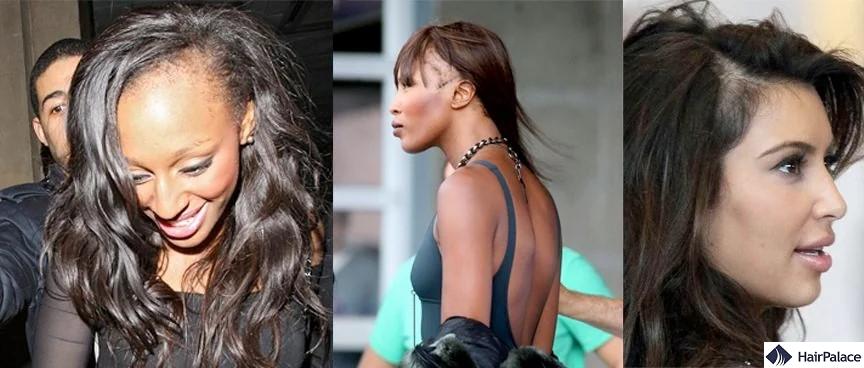
As demonstrated above, even superstars aren’t exempt from the impact of traction alopecia.
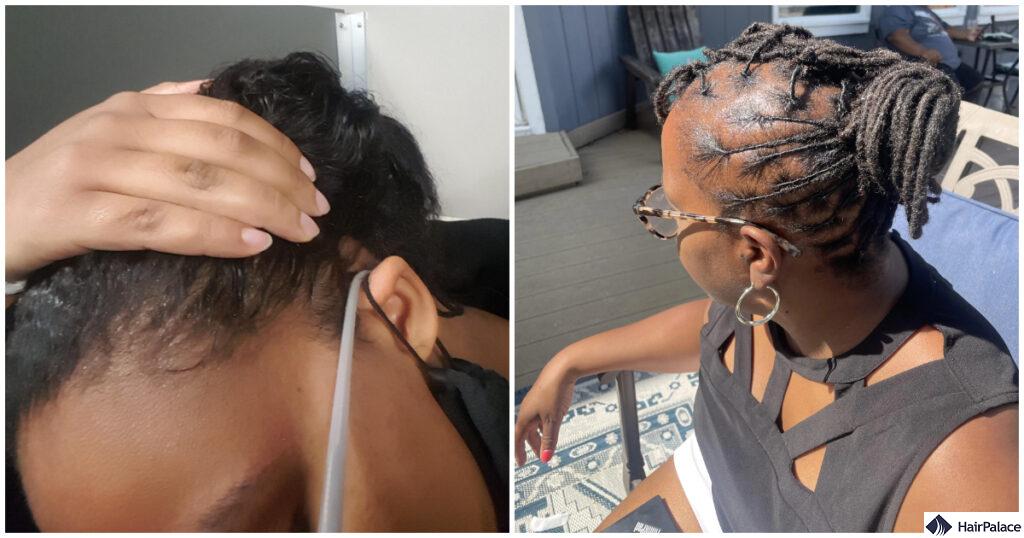
Traction alopecia treatment
Limit the use of heat styling tools, which can further damage weakened hair.
If you must wear your hair up or styled in a particular way, opt for protective hairstyles that minimize tension on the hair.
- Minoxidil (Rogaine): This over-the-counter medication can be applied to the scalp to stimulate hair growth.
- Corticosteroids: For cases where inflammation is present, topical or injected corticosteroids may be prescribed to reduce inflammation and promote hair regrowth.
- Platelet-Rich Plasma (PRP) Therapy: PRP involves drawing a small amount of your blood, processing it to concentrate the platelets, and then injecting it into the scalp to promote growth.
- Low-Level Laser Therapy (LLLT): LLLT uses red light to stimulate hair follicles and promote hair growth. It can be used as a supplementary treatment for traction alopecia.
- Hair Transplant Surgery: If traction alopecia or your receding hairline has progressed to the point of irreversible hair loss with significant scarring, hair transplant surgery might be considered.
- Scalp Massage: Regular scalp massage may improve blood circulation to the scalp, promoting healthier hair growth.
- Natural Oils: Some people use natural oils like castor oil or coconut oil to strengthen hair and reduce breakage, though evidence for their effectiveness in treating traction alopecia is anecdotal.
Last medically reviewed on April 11th, 2025
- Akingbola CO, Vyas J. Traction alopecia: A neglected entity in 2017. Indian J Dermatol Venereol Leprol. 2017 Nov-Dec;83(6):644-649. doi: 10.4103/ijdvl.IJDVL_553_16. PMID: 29035284.https://pubmed.ncbi.nlm.nih.gov/29035284/
- Afifi L, Oparaugo NC, Hogeling M. Review of traction alopecia in the pediatric patient: Diagnosis, prevention, and management. Pediatr Dermatol. 2021 Nov;38 Suppl 2:42-48. doi: 10.1111/pde.14773. Epub 2021 Aug 31. PMID: 34467569.https://pubmed.ncbi.nlm.nih.gov/34467569/
- Shimizu Y, Ntege EH, Sunami H, Inoue Y. Regenerative medicine strategies for hair growth and regeneration: A narrative review of literature. Regen Ther. 2022 Oct 31;21:527-539. doi: 10.1016/j.reth.2022.10.005. PMID: 36382136; PMCID: PMC9637724.https://pubmed.ncbi.nlm.nih.gov/36382136/
- Vañó-Galván S, Camacho F. New Treatments for Hair Loss. Actas Dermosifiliogr. 2017 Apr;108(3):221-228. English, Spanish. doi: 10.1016/j.ad.2016.11.010. Epub 2017 Jan 3. PMID: 28061966.https://pubmed.ncbi.nlm.nih.gov/28061966/
- Mounsey AL, Reed SW. Diagnosing and treating hair loss. Am Fam Physician. 2009 Aug 15;80(4):356-62. PMID: 19678603.https://pubmed.ncbi.nlm.nih.gov/19678603/


